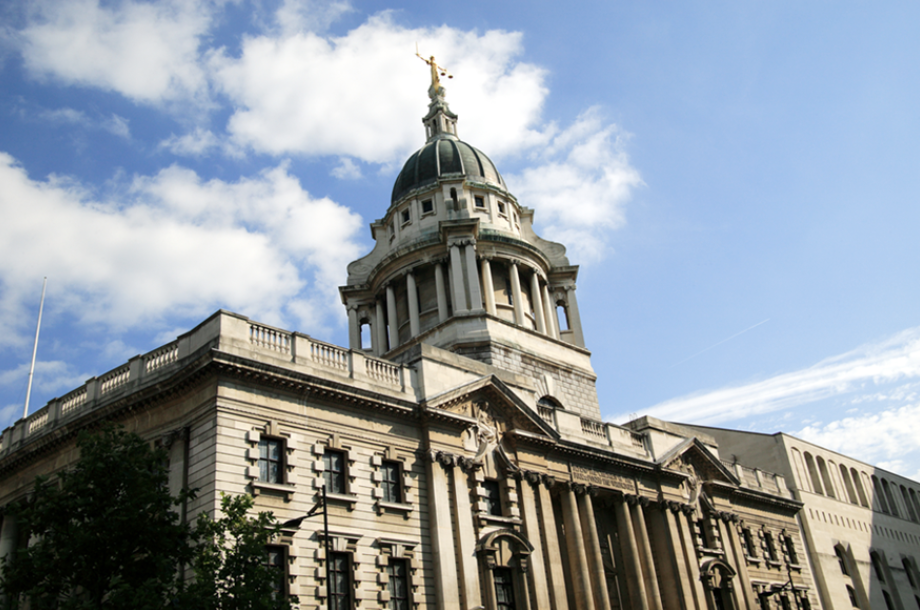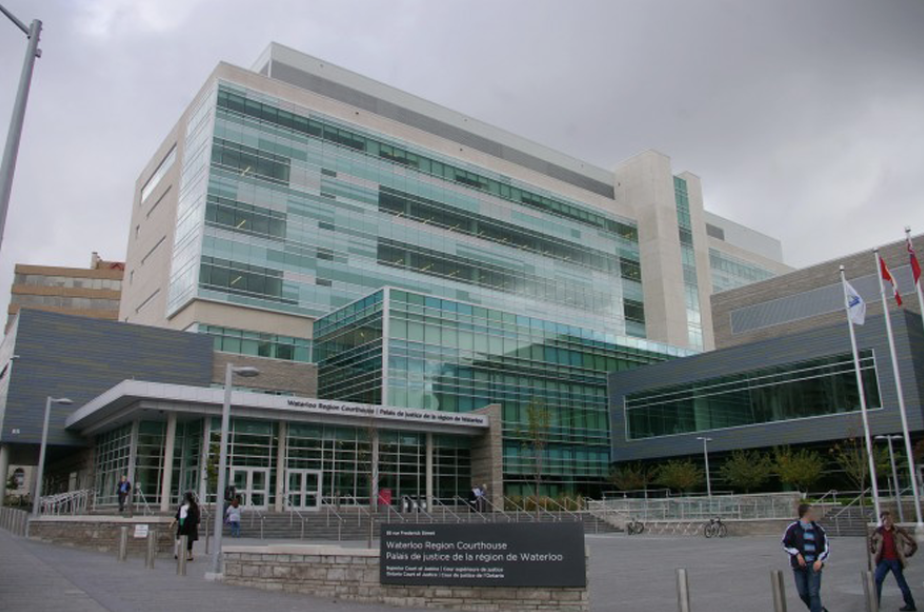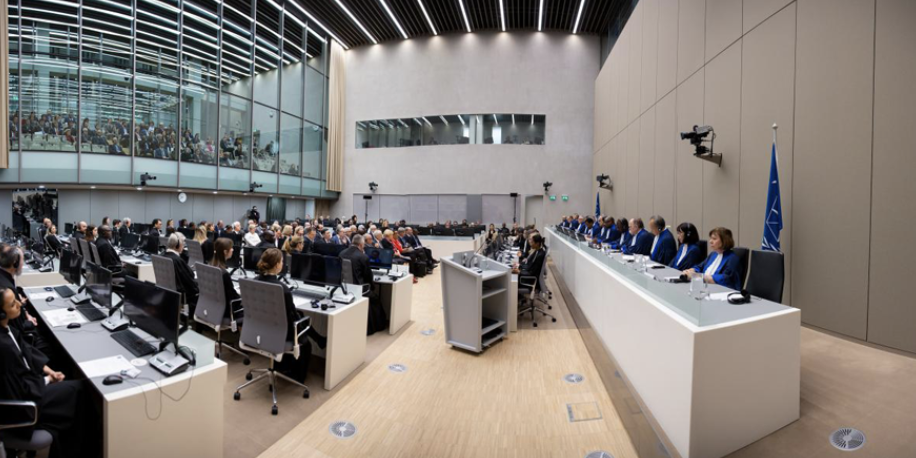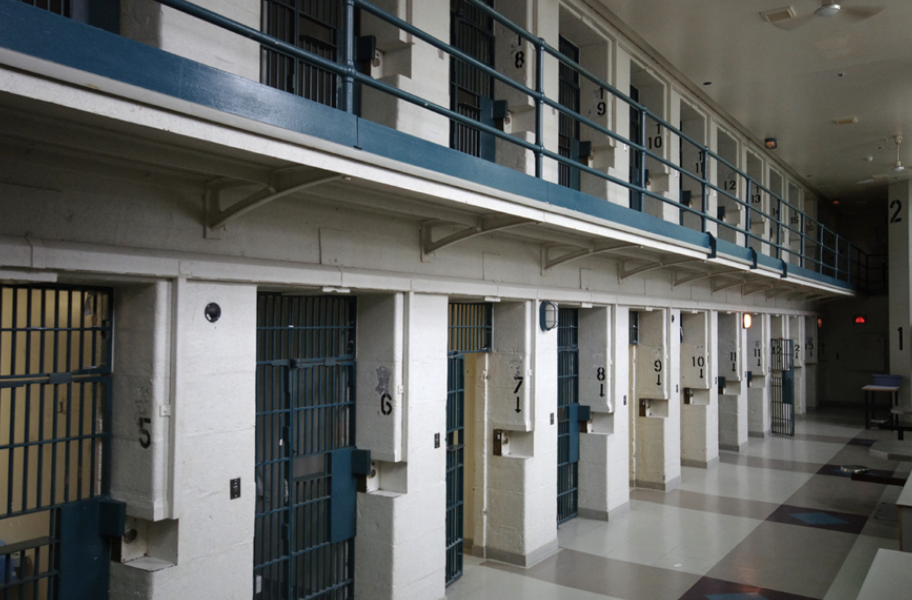Spaces of Law
Photo 1: This is the Old Bailey courthouse in London, UK.

- Where is law in the photo?
- The law may be contained in this building. In the papers, the files, the people that work in the building, the experts that move in and out of the rooms and hallways, the courtrooms and offices.
- If you were standing inside or outside this space, how would you feel?
- You may feel small. You may feel in awe of the architecture. You may feel intimidated. You may feel similar to standing underneath a grand old cathedral. You may feel excited or you may feel afraid.
- What does law feel like in this space?
- The law may feel powerful. Overwhelming. Controlling. Ancient. Majestic. Divine … What else?
- What does law smell like in this space?
- It may smell like the brick of the building or the exhaust from the street outside. It may smell like the movement of many bodies, all kinds of people entering and exiting this building … What else?
Photo 2: This is the Waterloo Region Courthouse.

- Where is law in the photo?
- The law may be in the building, in the files and papers that sit in filing cabinets or the data on the computers. The law may be in the briefcases of lawyers and judges walking in and out of the building, in and out of court rooms and offices …
- If you were standing inside or outside this space, how would you feel?
- You may feel unsure of where to go. You may feel small. You may feel confident to follow the signs. You may feel in control, or you may feel like you are not in control because cameras and security guards are watching you. You may feel as if you are doing something right, or you may feel that you are doing something wrong.
- What does law feel like in this space?
- Law may feel organized, structured, and institutional. It may feel modern. It may feel in control, or it may feel ambiguous and confusing. It may feel bureaucratic and procedural … What else?It may smell “clean,” sterile. It may smell like hand sanitizer and disinfectant.
- What does law smell like in this space?
- It may smell like the various smells of people walking in and out: perfumes, cigarette smoke, various odours mixing together … What else?
Photo 3: This is the International Criminal Court in the Hague, Netherlands.

- Where is law in the photo?
- The law may be the judges or the people observing from the gallery. It may be the cameras recording the proceedings or the translators making words understandable by all people present. It may be present in the computer data and information presented to the judges.
- If you were standing inside or outside this space, how would you feel?
- You may feel curious, you may feel intimated, you may feel like you are being watched or observed. Or you may feel like there is order and calm to the space, that your concerns are being listened to and addressed due to the bureaucratic order that exists in this space. If you are being called as a witness, you may feel afraid or you may feel protected. You may feel out of place.
- What does law feel like in this space?
- It may feel cold. It may feel sterile. Maybe it feels like law is an IKEA catalogue. Maybe the law enforces quiet. Maybe the law feels like a sovereign overarching everyone … What else?
- What does law smell like in this space?
- It may smell clean, or perhaps have no odour at all … So who decides this? Who cleans the air so that it is odourless?
Photo 4: This is a cell block at the Kingston Penitentiary in Kingston, Ontario.

- Where is law in the photo?
- Law may be the organization of this prison. The penalization of people who have broken the law. Law may be in the sentences that are given to the prisoners or in the way that the space is ordered. Law may be in the rules that govern this place, who is allowed to move in the hallways, how and why… . What else?
- If you were standing inside or outside this space, how would you feel?
- You may feel afraid. You may feel angry. You may feel trapped and powerless. Maybe you feel safe. Maybe you feel endangered. You may feel that the law is unjust or maybe that it is fair and just. You may feel cold, hot, tired, hungry … If you are a woman, you may feel differently than a man. If you are Black, you may feel different than a white person. If you are Indigenous, you may feel very differently than a settler within these walls … What else?
- What does law feel like in this space?
- The law may feel harsh. It may feel inflexible. Or maybe there is a law within these walls that feels like a game. Maybe the law is flexible and can be maneuvered and learnt … What else?
- What does law smell like in this space?
- The law may smell like disinfectant. Maybe the law smells like the food that is given on a tightly controlled schedule. Maybe the law smells like books or materials that are given during certain hours of the day. Maybe the law’s absence is smelled when there is a lack of care given to the prisoners.
Law in Urban Living
These photos all represent places where law happens in the sense of trials, procedures, court hearings, and adjudication.
But what about spaces that are not conventionally legal or deemed “illegal”? In his 2001 article, sociologist Loïc Wacquant writes about the meeting of prison and ghetto. Wacquant argues that law manages the dispossession of place and autonomy over one’s life. Rather than improve the lives of people living in poverty — in particular, African American men in the US — Wacquant observed that the criminal justice system makes the ghetto more like a prison and the prison more like a ghetto. Race has become defined by both living in the ghetto and being incarcerated, such that African Americans living in poverty and “criminality” is almost expected rather than there be efforts made to alleviate poverty and incarceration. Poverty is treated, or managed, by incarceration in the prison system. This suggests that law is not used to improve people’s lives or their living conditions. Instead, law constructs and creates criminality and maintains poverty (Wacquant 2001).
Does this only happen in the US?
No
According to the Canadian Department of Justice, citing the 2017–2018 Annual Report of the Office of the Correctional Investigator (OCI), the numbers of incarcerated Indigenous people in Canada increased by 8 percent between 2008–2009 and 2017–2018. Indigenous inmates in federal institutions constituted 30 percent of inmates in 2018–2019. Meanwhile, Indigenous people represent only 5 percent of the overall Canadian population. Black adults accounted for 3 percent of the total adult population in Canada but represented 7 percent of inmates in federal institutions. Rates of federally incarcerated Indigenous women are also rising. Proportions of Indigenous incarceration have risen substantially in Canada over the past ten years, but the overall inmate population (Indigenous and non-Indigenous) has risen only slightly (see Department of Justice Canada 2020).
In the 2017–2018 Annual Report, the Correctional Investigator stated the following:
“In the ten-year period between March 2009 and March 2018, the Indigenous inmate population increased by 42.8% compared to a less than 1% overall growth [in the total adult custodial population] during the same period. As of March 31, 2018, Indigenous inmates represented 28% of the total federal in-custody population while comprising just 4.3% of the Canadian population. The situation continues to worsen for Indigenous women. Over the last ten years, the number of Indigenous federally sentenced women increased by 60%, growing from 168 in March 2009 to 270 in March 2018. At the end of the reporting period, 40% of incarcerated women in Canada were of Indigenous ancestry. These numbers are distressing.”
Indigenous people in Canada are much more likely to be incarcerated in Canada. Does this mean that Indigenous people are more likely to break the law? No. When you walk outside your home, go for a bike ride, or drive in a car, do you always follow each and every law? How often are laws broken? Are you at risk of being incarcerated?
Your thoughts and reflections on these questions will depend, as we learnt in the previous module, on your gender, race, ethnicity, gender and sexuality, socio-economic background, education, dis/ability, nationality, and so on. Intersectional identities will also contribute to your experience and relationship with the law.
Keep these reflections in mind as we turn to our next section, which considers spatial justice and law’s environment.